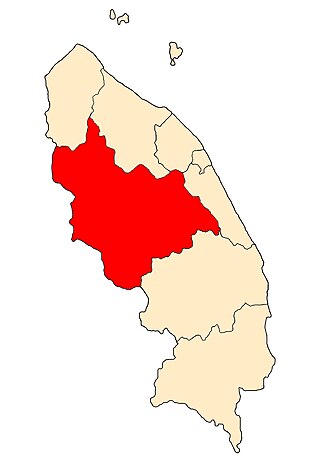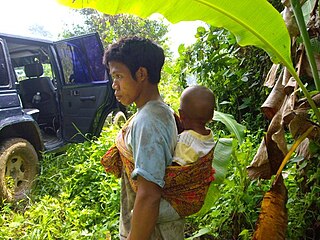
Pahang, officially Pahang Darul Makmur with the Arabic honorific Darul Makmur is a sultanate and a federal state of Malaysia. It is the third largest state in the country and the largest state in Peninsular Malaysia, and the ninth most populous. The state occupies the basin of the Pahang River, and a stretch of the east coast as far south as Endau. The state borders the Malaysian states of Kelantan and Terengganu to the north, Perak, Selangor and Negeri Sembilan to the west and Johor to the south, with the South China Sea is to the east. Pahang is separated from the west coast states by the Titiwangsa Mountains that forms a natural divider between the peninsula's east and west coasts from north to south, and from Terengganu in the east by the Pantai Timur Range. The state's highest elevation culminates at Mount Tahan in the eponymous Tahan Range, which is 2,187 metres (7,175 ft) high. Although two thirds of the state is covered by dense rain forest, its central plains are intersected by numerous rivers, and along the coast there is a 32-kilometre (20 mi) wide expanse of alluvial soil that includes the deltas and estuarine plains of the Kuantan, Pahang, Rompin, Endau, and Mersing Rivers.

Taman Negara is a national park in Peninsular Malaysia. It was established in 1938 and 1939 as the King George V National Park after Theodore Hubback lobbied the sultans of Pahang, Terengganu and Kelantan to set aside a piece of land that covers the three states for the creation of a protected area. After independence, it was renamed Taman Negara, which means "national park" in Malay.

Orang Asli are a heterogeneous indigenous population forming a national minority in Malaysia. They are the oldest inhabitants of Peninsular Malaysia.

Jakunpeople or Orang Ulu/Orang Hulu are an ethnic group recognised as Orang Asli of the Malay Peninsula in Malaysia.
Bera Lake is a natural freshwater lake system, located in Bera District, Pahang, Malaysia in the saddle of the main and eastern mountain ranges of Peninsular Malaysia, extending 35 km long and 20 km wide, drainings into the Pahang River. It lends its name to the Bera district and parliamentary constituency.

Temerloh is a municipality in central Pahang, Malaysia. Located about 130 kilometres (81 mi) from Kuala Lumpur along the Kuantan–Kuala Lumpur trunk road, Temerloh is the second largest urban area in Pahang after Kuantan, the state capital city. It is situated at the confluence of the Pahang and Semantan Rivers. Today, Temerloh usually refers to the territory under the administration of Temerloh Municipal Council which includes Mentakab, Lanchang, Kuala Krau and Kerdau.

The Batek people are an indigenous Orang Asli people ; belonging to the Semang group, who live in the rainforest of peninsular Malaysia. As a result of encroachment, they now primarily inhabit the Taman Negara National Park. The Batek are nomadic hunters and gatherers, so the exact location of their settlements change within the general confines of the area that they inhabit.

The Crocker Mountains form a range that separates the West Coast and Interior divisions of Sabah, Malaysia. At an average height of 1,800 metres (5,906 ft), it is the highest mountain range in the state. It is named after a 19th century British administrator of North Borneo, William Maunder Crocker.

Hulu Terengganu is an interior district of Terengganu, Malaysia. The seat of the district is Kuala Berang, located about 40 km (25 mi) from the state capital, Kuala Terengganu. The local government of this district is Hulu Terengganu District Council.

The Mah Meri are an ethnic group native to western part of Peninsular Malaysia. They are one of the 18 Orang Asli groups named by the Malaysian government. They are of the Senoi subgroup. Most of the members of the Mah Meri tribe live along the coast of South Selangor from Sungai Pelek up to Pulau Carey, although there is at least one Mah Meri Community on the other side of the Klang River.
The Duano' people, also called Desin Dolak or Desin Duano' are an indigenous people of Malaysia and Indonesia and can be found in islands along the northeastern region of Sumatra, Indonesia where most Duano' people have traditionally lived. They are one of the Proto-Malay group of cultures. Due to their nomadic boat lifestyle, based almost exclusively on fishing and collecting shellfish and crustaceans by using mud-boards, Duano' people are often categorized as Orang Laut, a group that includes the Urak Lawoi’ people and Moken people of the northern region of the Malacca Strait and the Andaman Sea. Although there are similarities in their way of life, they are a separate ethnic group. Citing their own language, culture, identity, and economic complexities, they deny being Orang Laut.

The Temuan people are a Proto-Malay ethnic group indigenous to western parts of Peninsular Malaysia. They can be found in the states of Selangor, Pahang, Johor, Negeri Sembilan and Malacca. The Temuans are classified as part of Orang Asli group according to the Malaysian government. They are also one of the largest and the most widespread of the Orang Asli ethnic groups.

The Senoi are a group of Malaysian peoples classified among the Orang Asli, the indigenous peoples of Peninsular Malaysia. They are the most numerous of the Orang Asli and widely distributed across the peninsula. The Senois speak various branches of Aslian languages, which in turn form a branch of Austroasiatic languages. Many of them are also bilingual in the national language, the Malaysian language.
Jakun is an Austronesian language, perhaps a dialect of Malay, spoken in Malaysia. Specifically it is spoken on the east coast and inland of Peninsular Malaysia, around the Pairang River, from Pekan in Pahang to Sri Gading, east to Benut, northwest to middle Muar River area around the districts of Segamat, Muar and Tangkak in Johor. It is also known as Djakun, Jakoon, Jaku’d, Jakud’n or Orang Hulu.

The Temiar are a Senoic group indigenous to the Malay Peninsula and one of the largest of the eighteen Orang Asli groups of Malaysia. They reside mainly in Perak, Pahang and Kelantan. Their total population is estimated at around 40,000 to 120,000, most of which live on the fringes of the rainforest, while a small number have been urbanised.

Orang Seletar are one of the 18 Orang Asli ethnic groups in Malaysia. They are classified under the Proto-Malay people group, which forms the three major people group of the Orang Asli. The Orang Seletar are also considered as part of the Orang Laut, natives of the Straits of Johor; separating Singapore from Peninsula Malaysia.

Jah Hut people are one of the Orang Asli tribes living in Pahang, Malaysia. As of 2000, the population of the Jah Hut people are 2,442 and by 2005, it is estimated that there are approximately 4,000 people living in 11 kampungs (villages) that are located along the west bank of the Pahang River from the north in Jerantut to the south in Temerloh, Pahang.

Semelai people are an Orang Asli people of the Proto-Malay people group found in Negeri Sembilan and Pahang states of Malaysia.
Temoq people belong to the Proto-Malay of the Orang Asli ethnic group that are found in Pahang, Malaysia.

Cheq Wong people are an indigenous Orang Asli people of the Senoi branch in Peninsular Malaysia. Although they have the physical appearance of the Senoi sub-group, the Cheq Wong language that they speak is closely related to the Northern Aslian languages.




















